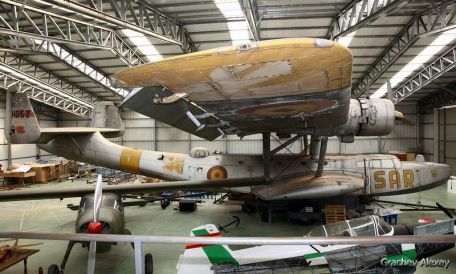History of Dornier Do 24
The Dornier Do 24 was a capable aircraft that served in limited numbers with the Allies and the Axis powers during World War II. Classified as an airship capable of operating on land and water, the system is a product of Deutsche Engineering and a requirement of the Dutch Navy.
The Do 24 completed its maiden flight on July 3, 1937, and entered service in November of the same year. A total of 279 prototypes were produced before, during and after the war, with several models in service until the early 1950s.
The design of the Do 24 is a traditional airship. The system features a hull-like hull with struts for added stability on the water. The wings are elevated monoplane systems supported by struts extending from the fuselage and sides. The cockpit is located forward of the wing, and the fuselage is accessed through a wide hinged door in the upper part below the wing assembly. Three BMW/Bramo Fafnir 323R-2 series 9-cylinder radial-piston air-cooled engines developing 1,000 hp each, delivering speeds of up to 340 km, are centrally mounted on the wing section above the fuselage body.
These engines feature a slim nacelle design and five-bladed propellers (Do 24 ATT). The tail is a split "T" type with two vertical tails protruding from the rear of the fuselage. Crew quarters are for 5 or 6 people.
The armament is strictly defensive - as expected, it is designed for - including two 7.92mm MG-15 machine guns in the bow and stern positions, 1 x 20mm MG-151 machine gun in the center of the hull, Up to 12 x 110 lb bombs (as required).
With the actual decommissioning of the Dutch Navy's Dornier Wals, the brand decided to replace it and commissioned the German aircraft company Dornier to design a replacement. From this request from the Netherlands, the Do 24 was born as an all-metal constructed system suitable for the operations required in the Dutch East Indies where they will be deployed.
The first early aircraft came with different engines, the first two being the Junkers Jumo, followed by three Wright Cyclones. Production takes place at factories in Germany and the Netherlands.
Everything went according to plan until the Germans finally captured the Netherlands, effectively destroying all future Dutch production systems. The German occupation forced the confiscation of all completed and under-construction systems for use by the Luftwaffe. Future models built at the Dutch factory will naturally shift the use of German powerplants away from the U.S.
Wright brand's offerings, including the BMW Bramall range. During World War II, the Do 24 was in service with the Germans, Australians (the existing Do 24 system was already operating in the East Indies) and Spain. Spain offers this type in a somewhat neutral role, providing search and rescue services to pilots on both sides of the conflict. The French took advantage of a time when the Swedes "captured" a German Do 24 that made an emergency landing in a neutral country.
The aircraft appeared in various configurations during its production life, the main differences being the engines and minor modifications.
DORNIER Do 24 size
Basic
Production
Roles
- Naval/Navigation
- Traffic
- Reconnaissance (RECCE)
Dimensions
72. 18 feet (22 m)
88.58 ft (27 m)
5.75m
Weight
9,100 kg
18,400 kg
Performance
Performance
211 mph (340 km/h; 184 knots)
19,357 ft (5,900 m; 3.67 mi)
2,952 miles (4,750 km; 2,565 nautical miles)
143 m/min
Armor
Default:
1 x 7.92 mm MG 15 machine gun in the bow position
1 x 7.92 mm MG 15 machine gun in rear position
1 x 20 mm MG 151 cannon in midship
12 x 110lb (50kg) bombs
Changes
Do 24K-1 - Original production model designation; 6 copies made.
Do 24K-2 - Licensed production model in the Netherlands; equipped with 3 Wright R-1820-G102 engines, 1,000 hp each.
Do 24N-1 - Licensed Dutch Search and Rescue (SAR) model for German use; equipped with 3 Wright R-1820-G102 series engines, 1,000 hp each; 11 copies made.
Do 24T-1 - French and Dutch production Do 24; 48 French-made examples; Dutch examples of BMW Bramo 323R-2 series engines.
Do 24T-2 - Based on Do 24T-1
Do 24T-3 - Based on Do 24T-1
Do 24 ATT - Equipped with 3 Pratt & Whitney Canada PT6A-45 series engines.
Do 318 - Single example model based on Do 24T.





